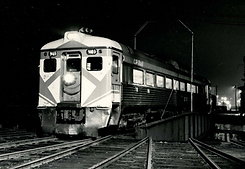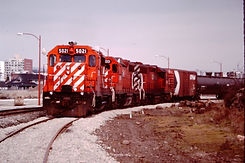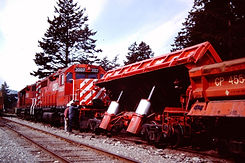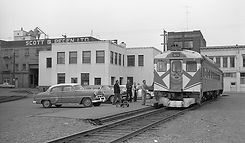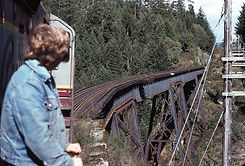esquimalt & nanaimo division
canadian railroad historical association
About Us
The E&N Division CRHA
The Esquimalt and Nanaimo Division of the Canadian Railroad Historical Association was registered as a non-profit organization and society on September 18th, 1997.
The E&N Division CRHA represents and maintains rail history along the entire E&N Railway corridor and is directly involved with the many aspects of its current status. We are based in Victoria, BC with additional activities and operations taking place mid-island in the Parksville and Coombs areas.
Our team is a network of personal contacts and resources cultivated from involvement as members of railway associations and as employees active and retired from the rail industry. This resource base also includes an extensive inventory of equipment and contractors available to us.
The purpose of our society is to preserve and maintain Island Rail artifacts and history, to reflect all aspects of railway transportation on Vancouver Island of the E&N, CPR, CNR, and industrial/logging railways; to acquire and maintain artifacts for a museum, to operate an excursion train, to record the history of all railways on Vancouver Island, to publish and disseminate accurate information, as well as collaborate with other groups of similar interest.
Our volunteers have helped restore rolling stock including our own ex-CN transfer caboose number 76695, two ex-CP Boxcars, various Maintenance of Way equipment, as well as a CPR baggage car.
In Victoria, we are working closely with Bayview Properties at the Victoria Roundhouse to establish a base within the heritage site. In Coombs, we have constructed a siding to store rail equipment from Parksville and a future interactive centre. Long-term plans include operating a railway museum and an excursion train operation.
We look forward to working co-operatively with similar societies and organizations towards common goals as well as welcoming new members and volunteers to our division whenever we can!
The Island's Rail History
The existing Island Rail Corridor, first known as the Esquimalt and Nanaimo (E&N) Railway, was incorporated on the 27th of September 1883 by Victoria coal baron Robert Dunsmuir, to support the coal and lumber industry and the Royal Navy Base at Esquimalt Harbour. Construction began on April 30th, 1884 and on the 13th of August, 1886 Prime Minister Sir John A. Macdonald drove home the last railway spike at Cliffside near Shawnigan Lake. The initial rail bed extended for 115 kilometres (71 miles) from Esquimalt to Nanaimo; hence the original name of the company. In 1888 the line was extended to the City of Victoria.
The E&N Railway was to have fulfilled the agreement which brought British Columbia into confederation to become a Province of Canada. Although it was never completed, it was still considered a small piece of the Trans-Continental Rail System.
In 1905, Robert Dunsmuir's son James sold the railway company to the Canadian Pacific Railway (CPR) who extended it to Lake Cowichan, Port Alberni, Parksville, Qualicum Beach and finally Courtenay. At its peak, the E&N Railway had 45 stations on the mainline and 8 on the Port Alberni line. Today about 25 stations remain with the majority unused and in a state of disrepair.
Under CPR ownership, the mainline Victoria Subdivision extension from Parksville to Courtenay was completed and opened in 1914. The total lengths of subdivisions on the E&N at its peak are as follows: Victoria Subdivision, 139.7 miles; Port Alberni Subdivision, 37.9 miles; Lake Cowichan Subdivision, 18.6 miles; Great Central Lake Subdivision, 10.3 miles; Osborne Bay Subdivision (later called the Crofton Spur), 2.6 miles. Total miles of all tracks ever identified as a subdivision of the E&N Railway: 209.1 miles (336 kilometres). This would be the all-time high and remained until circa 1952 when the Great Central Lake Subdivision was first removed from service and abandoned in 1953. The exact mileage the Great Central Lake Subdivision came off the Port Alberni Subdivision was Mile 35.6 at a location called Solly Junction.
In 1953, the CPR discontinued passenger train operations into Port Alberni. In 1979, VIA Rail (a Federal Crown Corporation) assumed operational responsibility for the remaining passenger service between Victoria and Courtenay, but the CPR retained ownership. VIA provided the rolling stock, passenger subsidy and ticket sales. Advertising was minimal so the railway was operating in isolation from the rest of Canada and North America. In 1998, CPR sold the east-west corridor between Parksville and Port Alberni to RailAmerica and entered into an agreement to carry freight, which was taken to the rail barge facility at downtown Nanaimo's Wellcox Yard. At that time approximately 8,500 carloads of forest and paper products, minerals and chemicals were transported by rail on the Island each year.
More changes occurred when Norske company, which owned mills in Port Alberni, discontinued the use of rail service due to poor handling and management on RailAmerica's part and opted for truck freight instead. With the loss of this significant revenue stream, RailAmerica announced its intention to cease operations and leave Vancouver Island.
The railway on Vancouver Island had been operating in uncertainty for a number of years. Only a few freight customers remained and the trend that saw a general downturn of railways in North America was reflected in this part of the Trans-Canada Railway System.
Vancouver Island citizens and communities were strong proponents of keeping the railway running and improving maintenance. Many groups tried to influence those who were responsible, but the decline continued. Finally, when RailAmerica announced that they would no longer provide freight or passenger service, communities on the island rebelled. The people of Vancouver Island now own the E&N right-of-way. It is managed by a non-profit foundation with the Victoria and Port Alberni subdivisions still legally classified as active track, although currently dormant. The Cowichan Sub no longer exists and a section of the Port Alberni Subdivision is used for a tourist operation; with the remaining portion out of service.
Presently, as of March 2011, VIA Rail passenger service has been suspended on the Island due to deferred maintenance of the railway and subsequent infrastructure conditions; however, limited freight operations continue in Nanaimo.
The E&N Division has been instrumental in the organization of E&N Railway Days, held annually, in a township along the E&N Railway since 1997. The celebration is in recognition of where construction crews from Esquimalt and Nanaimo met, completing the railway. The first train arrived from Esquimalt shortly after 9:00 am on August 13, 1886, at Cliffside Station (Mile 25.0) on the E&N Railway near Shawnigan Lake, BC. Here the party disembarked and Sir John A. MacDonald, provided with a golden spike and silver hammer by Dunsmuir's Chief Engineer, Joseph Hunter, drove home the last spike. This was significant for it demonstrated the completion of the government's promise to the province of British Columbia in joining the confederation of Canada for a Trans-Continental Railway System that included the Colony of Vancouver Island.




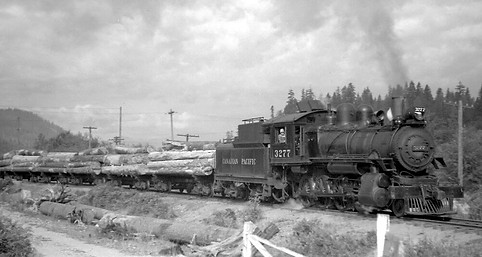


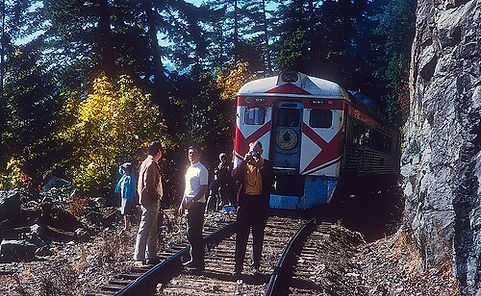



Our Equipment
Ex CPR (E&N) 40' Double-Door Boxcar
This boxcar was donated by CPR in 2002 and recently sold to Bayview Properties in Victoria.
This car is currently stored at the E&N Roundhouse in Victoria.
Ex CPR 40' Single-Door Boxcar
This boxcar was donated by CPR in 2005 and recently sold to Bayview Properties in Victoria.
This car is currently on display below Bayview's Offices near the E&N Roundhouse.
Ex CNR Transfer Caboose #76695
This caboose was donated by CN in 1996 and fully restored by our division in 1997.
It is currently stored inside the Victoria Roundhouse undergoing renovation.
Ex CPR Baggage Car #4231
This Express Baggage car was built in June 1948 as a lightweight groove series car for the CPR.
It was sold by CP to a member of the E&N Division in 2007 and brought to Vancouver Island.
It remains under private ownership and is used for displays during public events.
Ex CPR SW800 #6703
6703 was built in the 1950s for CP and operated mostly in Western Canada.
It was sold to the Interfor Grand Forks Division mill in the early 1980s on the KVR.
Recently 6703 has been donated to our E&N Division by Interfor - learn more HERE
Ex SP SW900 #1197 (#16, #696)
Built in the 1950s for SP and purchased by MacMillan Bloedel in Port Alberni numbered as 16.
In 2001 it was renumbered as 696 and transferred to the Catalyst pulp mill in Powell River.
When the Powell River mill closed it was moved to the Crofton mill for storage.
In April 2022 it was donated to our E&N Division by Paper Excellence.

